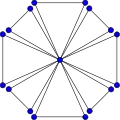Friendship graph
In the mathematical field of graph theory, the friendship graph (or Dutch windmill graph or n-fan) Fn is a planar undirected graph with 2n+1 vertices and 3n edges.[1]
| Friendship graph | |
|---|---|
 The friendship graph F8. | |
| Vertices | 2n+1 |
| Edges | 3n |
| Radius | 1 |
| Diameter | 2 |
| Girth | 3 |
| Chromatic number | 3 |
| Chromatic index | 2n |
| Properties | |
| Notation | Fn |
| Table of graphs and parameters | |

The friendship graph Fn can be constructed by joining n copies of the cycle graph C3 with a common vertex.[2]
By construction, the friendship graph Fn is isomorphic to the windmill graph Wd(3, n). It is unit distance with girth 3, diameter 2 and radius 1. The graph F2 is isomorphic to the butterfly graph.
Friendship theorem
The friendship theorem of Paul Erdős, Alfréd Rényi, and Vera T. Sós (1966)[3] states that the finite graphs with the property that every two vertices have exactly one neighbor in common are exactly the friendship graphs. Informally, if a group of people has the property that every pair of people has exactly one friend in common, then there must be one person who is a friend to all the others. However, for infinite graphs, there can be many different graphs with the same cardinality that have this property.[4]
A combinatorial proof of the friendship theorem was given by Mertzios and Unger.[5] Another proof was given by Craig Huneke.[6] A formalised proof in Metamath was reported by Alexander van der Vekens in October 2018 on the Metamath mailing list.[7]
Labeling and colouring
The friendship graph has chromatic number 3 and chromatic index 2n. Its chromatic polynomial can be deduced from the chromatic polynomial of the cycle graph C3 and is equal to .
The friendship graph Fn is edge-graceful if and only if n is odd. It is graceful if and only if n ≡ 0 (mod 4) or n ≡ 1 (mod 4).[8][9]
Every friendship graph is factor-critical.
Extremal graph theory
According to extremal graph theory, every graph with sufficiently many edges (relative to its number of vertices) must contain a -fan as a subgraph. More specifically, this is true for an -vertex graph if the number of edges is
where is if is odd, and is if is even. These bounds generalize Turán's theorem on the number of edges in a triangle-free graph, and they are the best possible bounds for this problem, in that for any smaller number of edges there exist graphs that do not contain a -fan.[10]
References
- Weisstein, Eric W. "Dutch Windmill Graph". MathWorld.
- Gallian, J. A. (January 3, 2007), "Dynamic Survey DS6: Graph Labeling" (PDF), Electronic Journal of Combinatorics, DS6, 1-58, archived from the original (PDF) on January 31, 2012, retrieved September 16, 2009.
- Erdős, Paul; Rényi, Alfréd; Sós, Vera T. (1966), "On a problem of graph theory" (PDF), Studia Sci. Math. Hungar., 1: 215–235.
- Chvátal, Václav; Kotzig, Anton; Rosenberg, Ivo G.; Davies, Roy O. (1976), "There are friendship graphs of cardinal ", Canadian Mathematical Bulletin, 19 (4): 431–433, doi:10.4153/cmb-1976-064-1.
- Mertzios, George; Walter Unger (2008), "The friendship problem on graphs" (PDF), Relations, Orders and Graphs: Interaction with Computer Science
- Huneke, Craig (1 January 2002), "The Friendship Theorem", The American Mathematical Monthly, 109 (2): 192–194, doi:10.2307/2695332, JSTOR 2695332
- van der Vekens, Alexander (11 October 2018). "Friendship Theorem (#83 of "100 theorem list")". metamath@googlegroups.com (Mailing list).
- Bermond, J.-C.; Brouwer, A. E.; Germa, A. (1978), "Systèmes de triplets et différences associées", Problèmes Combinatoires et Théorie des Graphes (Univ. Orsay, 1976), Colloq. Intern. du CNRS, 260, CNRS, Paris, pp. 35–38, MR 0539936.
- Bermond, J.-C.; Kotzig, A.; Turgeon, J. (1978), "On a combinatorial problem of antennas in radioastronomy", Combinatorics (Proc. Fifth Hungarian Colloq., Keszthely, 1976), Vol. I, Colloq. Math. Soc. János Bolyai, 18, North-Holland, Amsterdam-New York, pp. 135–149, MR 0519261.
- Erdős, P.; Füredi, Z.; Gould, R. J.; Gunderson, D. S. (1995), "Extremal graphs for intersecting triangles", Journal of Combinatorial Theory, Series B, 64 (1): 89–100, doi:10.1006/jctb.1995.1026, MR 1328293.
